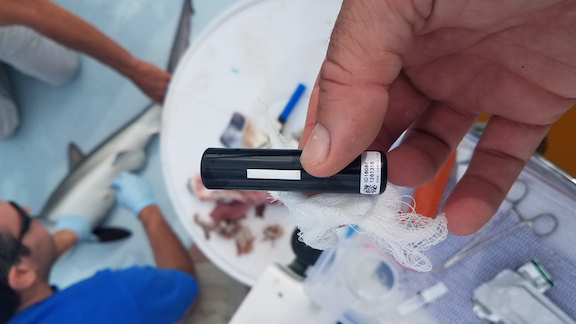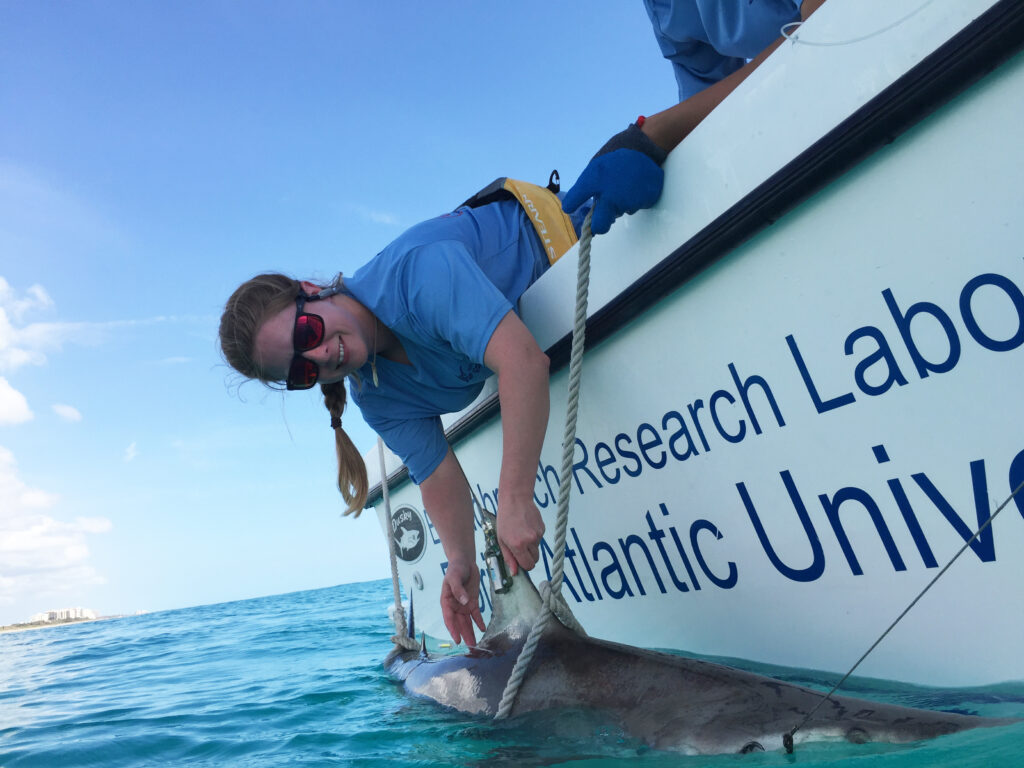by Sara Aoki
Beth Bowers follows the journeys of aquatic animals, using tags that transmit sound signals. As a new postdoc in SERC’s Fisheries Conservation Lab, she’s now using her skills to study how offshore wind farms could impact marine life along the Atlantic coast. Her specialty is “acoustic telemetry”—a technology where scientists outfit animals with special acoustic tags to track their movements underwater. By knowing where animals move, feed and breed, governments can make better decisions about how we develop renewable energy while minimizing impacts to the environment.
In this Q&A, Beth explains how acoustic telemetry works, her hopes for the future and advice for aspiring scientists. Edited for brevity and clarity.
How could offshore wind impact animals underwater?
Offshore wind energy development has the potential to impact animals in many ways at different stages, but we’re not really sure what the effects are yet, which is why it needs to be studied. Pre-construction is the optimal time to collect baseline data. We need to know how animals are currently using the environment before we can determine whether they were affected by offshore wind. Construction of offshore wind can, one, increase boat traffic to and from offshore leased areas, two, increase noise levels that could disturb animals, particularly marine mammals, and three, increase sediment suspension, which could decrease water quality.
…
It is important to remember that offshore wind is a necessary step towards lowering carbon emissions and mitigating the effects of global climate change, which are already impacting marine species. The Northwest Atlantic is one of the fasting-warming ocean regions on the planet. These studies help us to determine how this new technology will affect the environment so that we can minimize, mitigate, or prevent negative impacts, and how we can distinguish these impacts from global climate change.
What is your current project?
I am coordinating and communicating with researchers and offshore wind companies and their contractors to develop a Best Practices Guide for acoustic telemetry, and how it can be used with offshore wind.…We need research methods to be operable between different groups in a standardized way so that different groups can use the data. We want the data to be useful in the future.
Break this down for me. How do animals get tagged, and how do those tags get picked up?

The transmitter sends out pings, and when the animal swims by a receiver, the receiver records the transmitter’s unique ID code, date, and time. You either attach the sensors to the fish externally or surgically insert them. Surgical insertion is preferred because the external transmitters can get fouled in the ocean, which disrupts the signal, or tangled in debris which then harms the animal.
One thing I would say about how the technology works is that the animal, once it has been tagged and released, can go anywhere. When your animal travels outside of your array and pings on someone else’s receivers, then you start to expand your study site. The receiver owners could share the data with you and that is where cooperative telemetry networks help — they facilitate that data sharing. This makes it possible to track animals over great distances, like from Florida to Canada.
Read more: How scientists perform cownose ray surgery and shark surgery for fast recovery
What drew you to acoustic telemetry?
The biggest appeal to anyone, including myself, is that it is more cost effective than other tracking technologies such as satellite telemetry.…But you still have a tradeoff. With acoustic tracking, you are spatially bound to the listening stations. So, there can be a little bit of a limitation there. But you get a much bigger sample size because of the lower cost and longer-term data. However, with collaborative acoustic telemetry networks, that spatial tracking coverage is greatly increased.
Has acoustic telemetry done anything surprising?
This technology has helped us, as researchers, to identify unforeseen findings and things we would not have anticipated with the animals. One example is the blacktip shark, which is popular in recreational fishing. We previously thought that their migration spanned from southeastern Florida to North Carolina. However, based on information collected with acoustic telemetry, we discovered some individuals migrate from southeastern Florida all the way up to Long Island, New York. We discovered this because of the operability between adjacent collaborative acoustic telemetry networks. Without that collaboration, we would not have known that the blacktip sharks in southeastern Florida were some of the same ones in New York.
What is your favorite part of this research?
It is a new type of job for me. I have to step outside of the research itself and think about what the offshore wind industry can see: How do I reach them? Who has a stake in these projects? How do I best communicate in an efficient and accessible way?
What’s the most fun part of your job?
I like that this project is so open. It allows me to be creative in ways that I don’t generally get to be.
What is the end goal of your project?
There is a quote that I really love:
“I am hopeful the final products… will bring us closer to respectful, sustainable uses of our natural resources that elevate the quality of life of our friends and families and neighbors.”
The quote is originally from Nicole Angeli, Director of USVI DFW [U.S. Virgin Islands, Division of Fish and Wildlife], in reference to spatial suitability modeling for offshore wind areas. I like it because it’s what any scientist wants when they are evaluating how we are harnessing environmental resources….This is certainly my hope for our Best Practices Guide.
Do you have any advice for aspiring scientists?
Volunteer with local nature centers or with local researchers, and be persistent! Researchers are often overwhelmed with tasks and so you may need to reach out multiple times before you get a response. Don’t take “no response” as a no. Keep trying!


